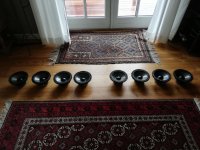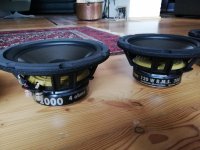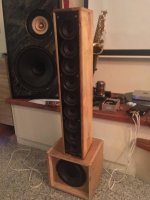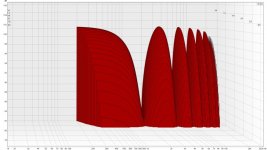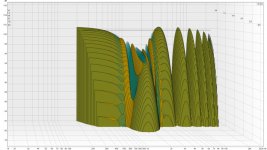Hi Wesayso,
Thanks for you elaborate answer, I now have kinda understand how you came to your filter. I am now looking into how to measure the optimal MS filter using my room equalization algorithm, as I can imagine that the required correction is room-dependent.
Next to feeding my left and right loudspeaker measurements for different measurement locations around the sweet spot separately into my equalization algorithm, I now also feed the phantom (= 0.707*left + 0.707*right), which includes the cross talk into the equalization. Thus for this I use intensity panning and to refine this even further, a filter g is used to model the shielding of the head (HRTF). So I do for the left ear (left(f)+ g(f) *right(f))/sqrt(1+abs(g(f))^2) and for the right ear (right(f)+ g(f) *left(f))/sqrt(1+abs(g)^2) and feed both "ears" together into the equalization algorithm. I don't know how to show you the resulting plots here (I do not have a web server to put the images on), but what I see is an additional 2 dB extra in the crosstalk part around 500 Hz (300-700 Hz ), confirming that there is indeed additional energy in the midrange for the phantom source due to crosstalk. Now I will incorporate the results of the equalizations into an MS filter.
Thanks for you elaborate answer, I now have kinda understand how you came to your filter. I am now looking into how to measure the optimal MS filter using my room equalization algorithm, as I can imagine that the required correction is room-dependent.
Next to feeding my left and right loudspeaker measurements for different measurement locations around the sweet spot separately into my equalization algorithm, I now also feed the phantom (= 0.707*left + 0.707*right), which includes the cross talk into the equalization. Thus for this I use intensity panning and to refine this even further, a filter g is used to model the shielding of the head (HRTF). So I do for the left ear (left(f)+ g(f) *right(f))/sqrt(1+abs(g(f))^2) and for the right ear (right(f)+ g(f) *left(f))/sqrt(1+abs(g)^2) and feed both "ears" together into the equalization algorithm. I don't know how to show you the resulting plots here (I do not have a web server to put the images on), but what I see is an additional 2 dB extra in the crosstalk part around 500 Hz (300-700 Hz ), confirming that there is indeed additional energy in the midrange for the phantom source due to crosstalk. Now I will incorporate the results of the equalizations into an MS filter.
One more thing to consider, with stereo mixes some form of EQ compensation may have been applied in mixing/mastering. This becomes most obvious when you listen to true multi channel mixes, played back without an actual center channel.
So don't overdo it and apply about a quarter of the edits ( but inverted) to the left/right sides. This is to counter the left/right info that will be present in the phantom mix (L+R keeps some of the side material in there).
See my graphs for some clarity.
So don't overdo it and apply about a quarter of the edits ( but inverted) to the left/right sides. This is to counter the left/right info that will be present in the phantom mix (L+R keeps some of the side material in there).
See my graphs for some clarity.
It has been said before in this thread, but the amount of (early) reflections can influence how much of this is heard. As I have absorbed most of the early reflections the mid/side EQ makes quite the difference.
From this paper: http://www.sfxmachine.com/docs/FixingThePhantomCenter.pdf
This is what we play with, with the mid/side EQ. For home theatre I intend to play with adding virtual early reflections to the phantom signal only.
That does require splitting the stereo track into 4 different streams, (L-R), (L+R), (R+L) and (R-L) so I can process each of them individually.
If this works for multi channel mixes I might not need a center helper.
It will be a bit harder, but not impossible for me to use this for Stereo, as I already have claimed 8 channels of processing if I include the subs.
For those with higher levels of early reflections at the listening spot, they must think I'm crazy 😀. If I raise the level of the sides compared to the phantom center I get greater intelligibility of the phantom material. Definitely a clue that the recorded reflections, contained in the side channels, add to fill in the cross talk holes. Doing this virtually in a controlled way might be beneficial, together with the mid/side EQ.
It is worth testing this, as the benefits are not small.
So far in all my experiments I found that a relative untreated room has a high "they are here" kind of perception(*). I am trying to maximise the "You are there" as it exists in the recording. That's the reason for all of this rambling. 🙂
(*) Definitely not a bad kind or variant of perception, it is a lot of fun to listen to. I can certainly accept it would please most of us.
I just like to learn what's possible and have come quite close to having the feeling of "being there". I really like that as an experience,
it's almost like listening to a time machine. 🙂
I'll shut up now, just wanted to give some insights as to why I keep trying to solve this puzzle, as it is worth it.
From this paper: http://www.sfxmachine.com/docs/FixingThePhantomCenter.pdf
On the subject of comb filtering and room reflections,
Clark stated:
• “Response notches are annoying if not filled in by
reflections.”
• “Response notches are almost inaudible if the notches
are filled in by reflections within 10 ms.”
• “Stereo reproduction depends on room reflections.”
[!]
• “Very dead rooms leave audible comb filtering.”
• “Perhaps as the interference pattern of the stereo
speakers becomes sufficiently dense it is perceived as
adding to spaciousness. Listeners frequently
commented that two speaker mono sounds fuller,
more solid or has depth.”
This is what we play with, with the mid/side EQ. For home theatre I intend to play with adding virtual early reflections to the phantom signal only.
That does require splitting the stereo track into 4 different streams, (L-R), (L+R), (R+L) and (R-L) so I can process each of them individually.
If this works for multi channel mixes I might not need a center helper.
It will be a bit harder, but not impossible for me to use this for Stereo, as I already have claimed 8 channels of processing if I include the subs.
For those with higher levels of early reflections at the listening spot, they must think I'm crazy 😀. If I raise the level of the sides compared to the phantom center I get greater intelligibility of the phantom material. Definitely a clue that the recorded reflections, contained in the side channels, add to fill in the cross talk holes. Doing this virtually in a controlled way might be beneficial, together with the mid/side EQ.
It is worth testing this, as the benefits are not small.
So far in all my experiments I found that a relative untreated room has a high "they are here" kind of perception(*). I am trying to maximise the "You are there" as it exists in the recording. That's the reason for all of this rambling. 🙂
(*) Definitely not a bad kind or variant of perception, it is a lot of fun to listen to. I can certainly accept it would please most of us.
I just like to learn what's possible and have come quite close to having the feeling of "being there". I really like that as an experience,
it's almost like listening to a time machine. 🙂
I'll shut up now, just wanted to give some insights as to why I keep trying to solve this puzzle, as it is worth it.
Last edited:
I'll shut up now, just wanted to give some insights as to why I keep trying to solve this puzzle, as it is worth it.[/QUOTE]
I have to kick in with a comment here.
Even though, in my room, the level of early reflections control is not nearly as good as Wesayso has in his room, I have managed to get pretty good result, with the help from Wesayso, and the addition of the same mid/side eq is clearly audible here and every time I bypass it in Jriver, I miss the focus, articulation and tonal correctness in the middle of the stereo panorama.
On more note: I also stride for the sensation of being transferred to the venue of the recording instead of having an entire orchestra in my room 😀
I have to kick in with a comment here.
Even though, in my room, the level of early reflections control is not nearly as good as Wesayso has in his room, I have managed to get pretty good result, with the help from Wesayso, and the addition of the same mid/side eq is clearly audible here and every time I bypass it in Jriver, I miss the focus, articulation and tonal correctness in the middle of the stereo panorama.
On more note: I also stride for the sensation of being transferred to the venue of the recording instead of having an entire orchestra in my room 😀
The drivers has arrived to my sub-woofer system for my Line Arrays.
It will be two enclosures , almost floor to ceiling (213 cm high) placed in the corners left of left main array and right of right arrays.
WINisd predicts 101 dB max SPL @ 20 Hz for one subarray in 2 pi space (half space) so placed in the corners it will be almost in ½ pi space, gaining, I guess, 5 dB and, as there are two of them, another 3 dB.
The result is 109 dB @ 20 Hz and 96 dB @ 10 Hz...😀
It will probably be even higher as the room gain also will affect the result.
It will be two enclosures , almost floor to ceiling (213 cm high) placed in the corners left of left main array and right of right arrays.
WINisd predicts 101 dB max SPL @ 20 Hz for one subarray in 2 pi space (half space) so placed in the corners it will be almost in ½ pi space, gaining, I guess, 5 dB and, as there are two of them, another 3 dB.
The result is 109 dB @ 20 Hz and 96 dB @ 10 Hz...😀
It will probably be even higher as the room gain also will affect the result.
Attachments
Had a friend who asked me to build him a pair of speakers for his restaurant terrasse.
He wants good sound for rock songs, and maybe even have a small band once a while.
I was thinking about horns, TLs, and other stuff... then it dawn on me. Line arrays with subs. It's good to hang around here sometimes! 🙂 With this thread incorporating LA with subs now, I thought it would be the perfect match.
He doesn't need floor to ceiling arrays, probably something like the Bose L1. So, I took out my old test array box of 9 drivers, and mated it with a small sub. Very good first test!
Hopefully I can make the sales pitch and we can move forward on this.
I might even build me a pair at the same time! Building 2 or 4... almost the same thing!
He wants good sound for rock songs, and maybe even have a small band once a while.
I was thinking about horns, TLs, and other stuff... then it dawn on me. Line arrays with subs. It's good to hang around here sometimes! 🙂 With this thread incorporating LA with subs now, I thought it would be the perfect match.
He doesn't need floor to ceiling arrays, probably something like the Bose L1. So, I took out my old test array box of 9 drivers, and mated it with a small sub. Very good first test!
Hopefully I can make the sales pitch and we can move forward on this.
I might even build me a pair at the same time! Building 2 or 4... almost the same thing!
Attachments
Well the nearest is about ½ kilometers away, so I don´t think that will be an issue 😀poor neighbours!
😀
Hi koldby,
Great plan there 🙂 guess concept have big chance be the cleanest bass you ever heard in your nice looking home sweet home.
Great plan there 🙂 guess concept have big chance be the cleanest bass you ever heard in your nice looking home sweet home.
Thanks When I have it finished it you should come visit meHi koldby,
Great plan there 🙂 guess concept have big chance be the cleanest bass you ever heard in your nice looking home sweet home.

Would love that koldby many many thanks 🙂 looks really like a dream scenario of low distortion acoustic arrays.
I'm quite jealous you get to play with bass array, koldby 🙂
Should be interesting to see the differences with my 2 single subs.
Should be interesting to see the differences with my 2 single subs.
Had a friend who asked me to build him a pair of speakers for his restaurant terrasse.
He wants good sound for rock songs, and maybe even have a small band once a while.
I was thinking about horns, TLs, and other stuff... then it dawn on me. Line arrays with subs. It's good to hang around here sometimes! 🙂 With this thread incorporating LA with subs now, I thought it would be the perfect match.
He doesn't need floor to ceiling arrays, probably something like the Bose L1. So, I took out my old test array box of 9 drivers, and mated it with a small sub. Very good first test!
Hopefully I can make the sales pitch and we can move forward on this.
I might even build me a pair at the same time! Building 2 or 4... almost the same thing!
With a finite array it would be useful to think about shading schemes. However the usual shading would cut back the efficiency gain severely. A frequency dependent shading would be something worth trying though. But it isn't as straight forward to implement.
Is it possible to perform mid/side eq with only an MiniDSP-HD? Are there tools that could create a convolution filter that could perform the function? I very much want to experiment with this , but I do not want to use a computer and J-River for RT processing
I don't think you'll be able to do M/S EQ with the minidsp HD only.
Unless there is a way to do it in RePhase, and import the limited amount of taps into the unit. I'm not fluent enough in RePhase to answer that.
Unless there is a way to do it in RePhase, and import the limited amount of taps into the unit. I'm not fluent enough in RePhase to answer that.
mid/side EQ is a mixing of channels (using add/subtract). I doubt it could be done with MiniDSP, a search on a mid/side EQ plugin did not turn up anything useful.
I don't think you can do it in convolution, as you'd need to be able to encode/decode to mid/side.
I don't think you can do it in convolution, as you'd need to be able to encode/decode to mid/side.
Last edited:
Just a FYI, I'm working on the theory of the Fixing the Stereo Phantom Center again. I still believe there's a lot of potential locked in there.
I've had great fun with all of the experiments and right now I'm trying to mix two theories. Basically using the original shuffler idea as presented in that thread, but using it a bit differently. Sort of combining it with cross talk cancelation but a little different.
So far, the virtual try-outs seem better than the later phase shuffler ideas that developed in that linked thread. I'm using a "virtual" reflection, but timed a little late at ~2 ms (only for phantom sounds) and using it this way I can keep the left and right channel equally balanced. In my tests the phase shuffler had a preference for one side that worked better than the other (depending on where the phase turned). A slight imbalance when moving outside of the sweet spot. (theory and tests somewhere in this thread)
This new proposal fills each perceived dip with several close timed combing patterns, while the (pure) phase shuffler tried to fill it with two larger ones, hence the perceived imbalance in that one. The original shuffler from the paper also needs some tests to see how that one did, haven't tried that yet, but I expect it to be more similar to what I'm trying right now.
I haven't heard anything yet, as I need to re-route all of my channels to implement this. A lot of work, but with the availability of zones within JRiver I can work on it separately.
If anything comes from it I'll be sure to share both the idea as well as the results I get from it. I haven't forgotten what attracted me to the different experiments I tried so far. In theory, this current scheme has the potential to be beneficial at the sweet spot while not being detrimental for the other seats. The ideas in my head do translate very well to my RePhase/REW tests to test/validate these ideas. I hope they work as well in practice.
I'll show two waterfall plots to illustrate the difference between regular stereo cross talk (using 2 Dirac pulses) and my proposed tweak:

Regular Stereo cross talk (in worst case scenario)

My proposed tweak, code named "swopper" for now 🙂
As can be seen, I only targeted the biggest dip and plan to use it together with the mid/side EQ. I don't want to jeopardise the soundquality in non sweet spot seats.
The beauty of this tweak is that it sums at the exact mic position as if there's nothing done at all (a positive reflection in one channel, inverted reflection in the other side). I hope to use this advantage in the sides as well, as a phantom center also contains some side material. If all works well, the sides will be completely unaffected by this (that's the goal at least).
Anyway much more work (and thinking) to do!
I've had great fun with all of the experiments and right now I'm trying to mix two theories. Basically using the original shuffler idea as presented in that thread, but using it a bit differently. Sort of combining it with cross talk cancelation but a little different.
So far, the virtual try-outs seem better than the later phase shuffler ideas that developed in that linked thread. I'm using a "virtual" reflection, but timed a little late at ~2 ms (only for phantom sounds) and using it this way I can keep the left and right channel equally balanced. In my tests the phase shuffler had a preference for one side that worked better than the other (depending on where the phase turned). A slight imbalance when moving outside of the sweet spot. (theory and tests somewhere in this thread)
This new proposal fills each perceived dip with several close timed combing patterns, while the (pure) phase shuffler tried to fill it with two larger ones, hence the perceived imbalance in that one. The original shuffler from the paper also needs some tests to see how that one did, haven't tried that yet, but I expect it to be more similar to what I'm trying right now.
I haven't heard anything yet, as I need to re-route all of my channels to implement this. A lot of work, but with the availability of zones within JRiver I can work on it separately.
If anything comes from it I'll be sure to share both the idea as well as the results I get from it. I haven't forgotten what attracted me to the different experiments I tried so far. In theory, this current scheme has the potential to be beneficial at the sweet spot while not being detrimental for the other seats. The ideas in my head do translate very well to my RePhase/REW tests to test/validate these ideas. I hope they work as well in practice.
I'll show two waterfall plots to illustrate the difference between regular stereo cross talk (using 2 Dirac pulses) and my proposed tweak:
Regular Stereo cross talk (in worst case scenario)
My proposed tweak, code named "swopper" for now 🙂
As can be seen, I only targeted the biggest dip and plan to use it together with the mid/side EQ. I don't want to jeopardise the soundquality in non sweet spot seats.
The beauty of this tweak is that it sums at the exact mic position as if there's nothing done at all (a positive reflection in one channel, inverted reflection in the other side). I hope to use this advantage in the sides as well, as a phantom center also contains some side material. If all works well, the sides will be completely unaffected by this (that's the goal at least).
Anyway much more work (and thinking) to do!
Attachments
Last edited:
mid/side EQ is a mixing of channels (using add/subtract). I doubt it could be done with MiniDSP, a search on a mid/side EQ plugin did not turn up anything useful.
I don't think you can do it in convolution, as you'd need to be able to encode/decode to mid/side.
In typical MiniDSPs you can do the basic scaled add/subtract in the input matrix and filter the result. But the result goes directly to an output, precluding the chance to do the subsequent processing shown in Wesayso's diagram unless you cascade it to another MiniD or loop the result back to another input.
Is the FIR section based on a single FIR file per channel? Or can it work with config files like in convolver. You can do summing etc in a config file, but I bet you're still not quite where you'd want to be. Basically you'd need: encode EQ decode.
- Home
- Loudspeakers
- Full Range
- The making of: The Two Towers (a 25 driver Full Range line array)
